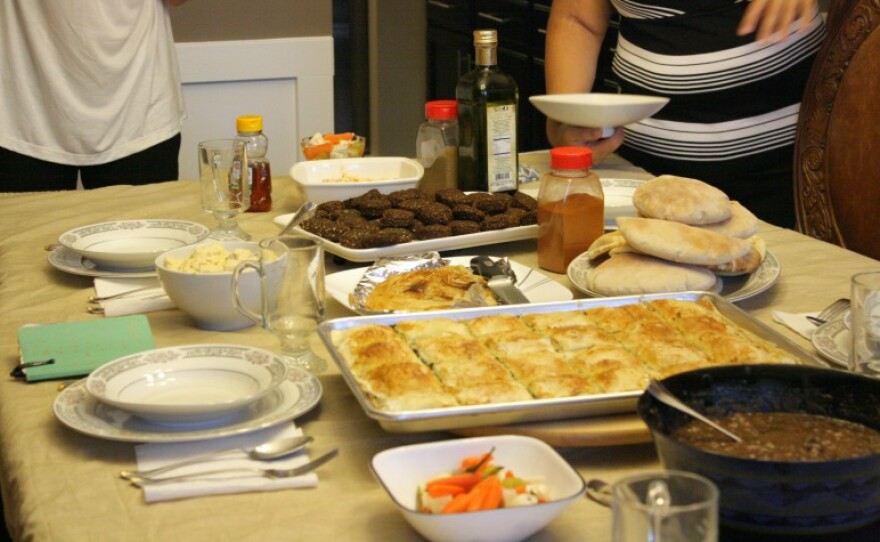The caption on the photo in my Instagram feed said: “My Egyptian co-worker brought an authentic Egyptian breakfast to share at the office!” Pictured was a plate of fool, a mixture of fava beans and red lentils, along with pita, hummus and pickles. I thought, I could go for some Egyptian food and proceeded to bend social media to my willful appetite.
That’s how I managed to meet Diana and Hany Assad. I coerced my Instagram crony into an introduction so that I might score a dinner invitation. As generosity would have it, the Assads were willing to meet for dinner.
Egyptian food is special to me. Years ago, my now deceased stepmother introduced me to the flavors of the Middle East. She spent a semester at American University in Cairo where she fell in love with Egyptian cuisine. I remember her worldly knowledge to be wildly exotic, an admirable trait that piqued my interest in both attending college and adventurous eating. At six years old, hummus was otherworldly compared to Kids Cuisines and grilled cheese sandwiches.
The simple flavors stayed with me well into college where falafel and tabbouleh became a way of life accounting for most of my meager college budget. This may explain why I prefer most things slathered in tahini or the reason why copious amounts of lemon, garlic and parsley are my solution to most everything in the kitchen.

Upon arrival, Diana Assad was prepping the falafel, a blend of chickpeas and fava beans mixed with cilantro, parsley and garlic. In the bowl, the mixture resembled a thick green paste. Diana stuffed the mixture into a mold and placed the peppermint-patty-sized orb into searing hot oil. A quick flip and the falafel emerge deeply browned and crisp.
Hany, a gregarious presence, was in charge of the pita bread warming in the oven. Puffed loaves of bread made by Hany’s mother, who recently came for a visit, were waiting to do some of the heavy lifting at dinner. Egyptian cuisine is largely vegetarian consisting of plenty of vegetables, legumes, cheese and herbs. Bread is a staple, in charge of getting most dishes from plate to mouth. Diana was stirring a crockpot full of fool, fava beans and red lentils, slow cooked into a comforting slurry seasoned with cumin, lemon and salt.
This dish, Diana said, was a special one. It was something her deceased father made.
“People called him the fool man,” said Diana.
Hany chimed in, “He really did make the best fool around.”

On the countertop, a binder teeming with papers yellowed from years of existence displayed handwritten family recipes. Diana maintains her connection to Egyptian culture in this way, cooking with well-loved recipes handed down from family members that came before.
She prepared the hummus next, a puree of chickpeas, tahini, garlic and lemon.
On the opposite counter, a tray full of sambousek rested. Made with phyllo dough, spinach and feta cheese, it is much like the Greek dish, spanakopita.
But, Diana said, “Don’t let that Greek family fool you. That’s Egyptian.”

Much of what she prepared for the evening is typical of what Egyptians eat for breakfast. The dinner table was filled with an assortment of dips and snacks to go with bread. There was labneh, strained yogurt topped with olive oil. Next to it, a dish of za’atar spice, a blend of dried thyme, sumac and toasted sesame seeds, mixed with olive oil for dipping. The table boasted plenty of cheese, a bowl of feta mixed with tomatoes and pickled cheese. In addition, there were pickled vegetables or, meekhalil, a mixture of carrots, cauliflower, celery and hot peppers. It reminded me of giardinera, the Italian equivalent.
We took dessert in the living room where an enthusiastic Hany played a few Egyptian songs on his high-dollar keyboard. Diana served Arabic coffee infused with cardamom and served a selection of small pastries imported from Egypt, and kunafa, a dessert made with shredded phyllo dough and cheese sweetened with a rosewater and orange blossom syrup.
We stayed later than expected and to date, it was the best breakfast for dinner I’ve had since childhood.












